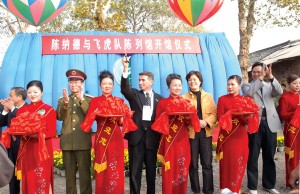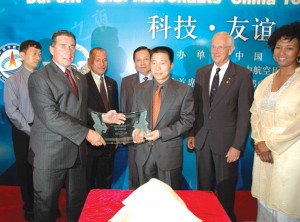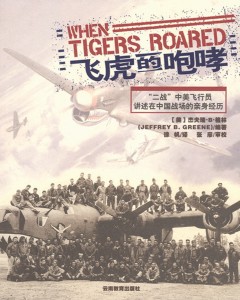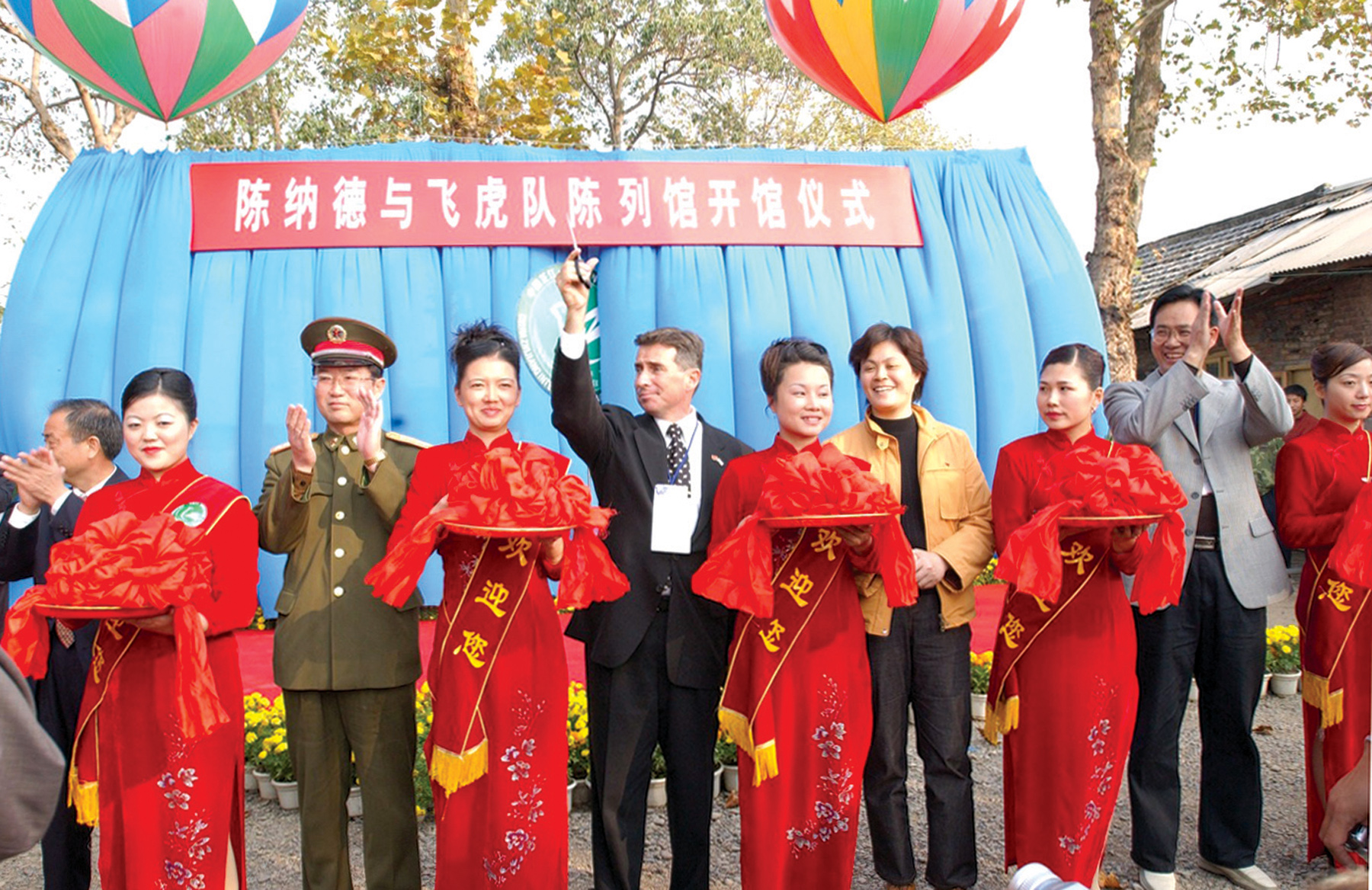By S. Clayton Moore

SAAHF director Jeff Greene cuts a ceremonial ribbon during the official opening of the Flying Tiger Museum at Zhi Jiang, China, on Nov. 15, 2003.
It sounds like a plot cribbed from a Clive Cussler novel. In 1998, a robust group of veteran pilots on a trip to China started fantasizing about raising a Curtiss P-40 Warhawk from murky Lake Dianchi in the Yunnan Province of Southwest China.
Since that time, the group has coalesced into one of the world’s most important cultural organizations. Originally formed to help support the excavation of the P-40, the Sino-American Aviation Heritage Foundation has expanded its mission to educate both American and Chinese citizens about the Flying Tigers and other efforts vital to the war in the Pacific. It also sponsors some of the most interesting cultural exchanges in recent history, such as this summer’s meeting between Colonel Yang Liwei, China’s first man in space, and three American astronauts, including Charles Bolden, four-time shuttle commander.
At the heart of the organization is its executive director, Jeff Greene, who has accomplished a lifelong dream by celebrating the veteran aviators of World War II. As a child, Greene imagined fighting Tokyo Joe and his Zero hordes, as part of the famous Flying Tigers, the nickname of the American Volunteer Group of fighter pilots that fought against the Japanese in China and Burma during the war. Today, the historian and writer counts those legendary pilots not simply as distant icons, but as friends.
“When Tigers Roared”
It’s impossible to underestimate the impact of the American Volunteer Group’s wartime contributions. Organized by Claire Chennault, a retired U.S. Army Air Corps major who had become a military adviser to Chiang Kai-shek, the Flying Tigers were a hardscrabble bunch of aviators who counted among their numbers pilots like Gregory “Pappy” Boyington, who went on to found the Black Sheep Squadron.
Over the winter of 1940-41, Chennault negotiated the purchase of 100 Curtiss P-40s from the United States and recruited 100 volunteer pilots, mostly reserve officers who were discharged to fight for China, and 200 ground crewmen. After painting the distinctive “shark’s mouth” on the front of their P-40s, inspired by the Luftwaffe’s Messerschmitt Bf-110s (fighting in Russia) and RAF P-40s (in North Africa,) they were dubbed the Flying Tigers by the Chinese people. From December 1941 until the 23rd Fighter Group replaced them in July 1942, the Flying Tigers destroyed more than 290 Japanese aircraft in vicious dogfights and daring raids.
The Flying Tigers were formally incorporated into the U.S. Army Air Force in 1942. By that time, Chennault had rejoined the Army with the rank of brigadier general. Eventually, he was promoted to major general as commander of the U.S. Army’s 14th Air Force, whose many members also carried on the Flying Tigers nickname.
“It was an eight-year struggle against the Japanese and it kept China in the war,” Greene explains. “You can honestly say that Chennault is the one foreigner in China during the war who saved more Chinese people than anyone else.”
The memory of Chennault and the Flying Tigers lives on in China today and has allowed Greene’s organization to gain unprecedented access to the American Volunteer Group’s original base near Kunming, China, and other important historic sites.
“The Chinese have never forgotten what the Flying Tigers and the 14th Air Force did for them,” Greene said. “Despite the Cold War, there’s this tremendous love and respect there. It’s the old Marine Corps thing—you raise the name Flying Tiger up the flagpole and everybody salutes.”
The Historian
Jeff Greene had always dreamed of becoming a Marine Corps fighter pilot and he was well on his way by the mid-seventies. Raised in Hollywood by comedienne and actress Marie Wilson (“My Friend Irma”), he joined the Army Reserve and soon switched over to the Marine Corps officer training program to be a pilot. But due to Saigon’s fall in April 1975, Greene’s dreams weren’t to be.
“After Saigon fell, they began getting rid of aviators with any degree of medical problem, as they do after every war,” Greene said. He had asthma. “My life was kind of ruined at that point because it was all I ever wanted to be.

A stone roller used during World War II to pave runways for the Flying Tigers is unveiled in Kunming by Yunnan Province Deputy Governor Cheng Yingxuan and Jeff Greene.
He trained horses for many years, traveling throughout Europe to buy and sell magnificent Arabian horses. He later decided to pursue his interest in writing and attended film school at UCLA. It turned out that Greene had a prodigious talent for producing, and in 1995, he was asked to produce a documentary on the American Volunteer Group for an early iteration of the Military Channel.
“The Flying Tigers let me hang with them over the years and many have become my closest friends,” Greene said.
Although that version of the documentary never aired, a trip to China with the veterans in 1997 sparked the beginnings of the Sino-American Aviation Heritage Foundation.
“I was sitting with Dick Rossi, Bob Layher and Bob Raine, of the original Flying Tigers, and we started talking about John Blackburn, who had crashed into the lake at Kunming in 1942,” Greene remembered. Bob Raine and John Blackburn were doing some aerial maneuvers and Bob lost sight of Blackburn, who went into the lake and was killed. We started speculating. Obviously, the AVG, working on a shoestring, didn’t have the equipment to recover the plane and the 14th Air Force wouldn’t have needed a waterlogged P-40. We assumed the plane was still there and started fantasizing about recovering it.”
Meanwhile, Greene’s documentary was brought back to life in 1998, when the Chinese Army asked him to co-produce a documentary on the Flying Tigers and Chennault. The film came on the heels of President Bill Clinton’s historic visit to China in 1998. It was during that visit that Clinton made a stirring speech (co-written by Greene) for Greene’s documentary about the Flying Tigers and the relationship between China and America. By the time the documentary aired, its cultural significance was enormous.
“With a little razzle-dazzle and a little luck, we put the show out two weeks after Clinton’s visit,” Greene said. “It’s still believed to be the most-watched documentary ever aired, with more than 300 million people watching on two major Chinese channels simultaneously. It’s given me something as a documentary filmmaker that no one else has done.”
“Operation Save the Tiger”
The press coverage gained the attention of the China Association for Exploration, a small-scale national geographic society primarily made up of veterans from the People’s Liberation Army. In 1998, its director, Yan Jiangzheng, began an extensive underwater search of Lake Dianchi, looking for the elusive P-40 that crashed into the lake more than 60 years ago.
“When it gets recovered, this is arguably one of the rarest airplanes in existence, from a historic standpoint,” Greene said. “There are a number of P-40s out there but this is an airplane actually used by the American Volunteer Group, and its sole survivor. This is an aircraft on the order of Amelia Earhart’s plane.”
In late 1998, Yan Jiangzheng asked Greene if he would create a nonprofit foundation to support the efforts of the China Association for Exploration, both financially and historically, and Greene agreed. The Sino-American Aviation Heritage Foundation was born.
While Greene has built the foundation up into an internationally renowned center for cultural exchanges, the China Association for Exploration has steadily been making gains on Blackburn’s plane. In early 2000, an expedition team discovered an underwater target that it identified as the lost P-40 fighter aircraft. The dimensions of the underwater target are consistent with that of an aircraft of the Curtiss P-40 family of fighters. However, the aircraft is buried in a thick layer of silt, beneath 15 feet of water.
“We’re very close,” Greene said. “It’s not very deep, but the waters are very dense and dark.”
In September, he took nearly 50 U.S. veterans of the Chinese-Japanese conflict out on a drilling barge to see the site. At one point, the engineers pulled up a wire that the veterans were able to identify as a control cable from the airplane.

With U.S. astronauts Maj. Gen. Charles Bolden, Brig. Gen. Charles Duke and Dr. Mae Jemison looking on, Jeff Greene presents China’s first astronaut, Col. Yang Liwei, with the Arthur Chin Aviation Achievement Award in Beijing on July 25, 2005.
Once raised, the plans are to restore the aircraft at a facility in Chino, Calif., before sending it on to a temporary exhibit at the Smithsonian and then to its final resting place at a museum in China. The team has secured a major Chinese sponsor for the project and hopes that an American sponsor will step up to assist with the project in the near future.
“When that plane comes out of the lake, every news camera in China will be there,” Greene said. “We’re asking American companies to have their name associated with the biggest manmade event in China short of the Olympics.”
Future projects include the recovery of a P-51 Mustang shot down over Hubai Province and the recovery and restoration of a B-25 Mitchell bomber flown by “Doolittle’s Raiders” that has been located off of China’s Yellow Sea coast.
The Sino-American Aviation Heritage Foundation
Greene’s accomplishments since the formation of the foundation have been remarkable.
“Our mission has grown,” Greene said simply. “We have an extraordinary board of over 200 founding members. Anyone who flew in China during World War II is eligible as a founding board member as well as any other significant aviators. It’s one of the most prestigious boards of aviators on the planet and it really is the whole image of the foundation.”
Foundation members include several of the original aviators from the American Volunteer Group and the 14th Air Force including aces like Dick Rossi, now president of the Flying Tigers Association, Peter Wright and Robert Layher. The elite group also includes several astronauts, two U.S. senators and several four-star generals and admirals.
Greene, in cooperation with the Chinese government, has managed to pull off several interesting exchanges between Chinese and American aviators.
“We’re the only organization in the world that has high-ranking American and Chinese generals who see each other on a regular basis and communicate through the language of aviation,” Greene said.
In 1997, Gen. Han Decai, a Chinese fighter ace who fought during the Korean War, asked Greene to bring along Hal Fischer, an American aviator and double ace that Decai shot down during the conflict. Greene coordinated the historic meeting in Shanghai, China between the two fighter aces who first met in combat over the Yalu River.
In October 2002, the organization cosponsored an exhibition of Chinese World War II photographs titled “The Memory of History” that was displayed at the Woodrow Wilton International Center for Scholars in Washington, D.C., and the George H.W. Bush Library in Texas.
Just last year, Greene and a delegation of his board members traveled to Yunnan Province on behalf of the National Museum of the United States Air Force, where the Chinese government donated a stone roller used to pave runways for the Flying Tigers to the National Museum of the United States Air Force in Dayton, Ohio.
“Without those runways, Chennault never could have had an air force to support the Chinese,” Greene explained. “Think of the hundreds of thousands of combat-hardened Japanese soldiers who could have been released into the Pacific or even into Europe. Imagine if 100,000 screaming Japanese had shown up at Stalingrad in the bottom of the ninth. Without those stone rollers, there would’ve been no air war that tied down a million Japanese soldiers who surely would have been causing trouble somewhere else.”
In July, Greene expanded the foundation’s frontiers to space when he took three astronauts-—Maj. Gen. Charles Bolden, Brig. Gen. Charles Duke and Dr. Mae Jemison—to China to meet Yang Liwei, China’s first astronaut, on an official visit sponsored by the Chinese government. In an interesting coincidence, Bolden first swore Greene into the Marine Corps 30 years ago.

Jeff Greene’s book, “When Tigers Roared,” is an oral history of the American and Chinese airmen who fought together during World War II.
“There are very few Americans that Yang Liwei has shaken hands with,” Greene said. “Sponsored by the DuPont Company, we were guests of the Chinese Society for Astronautics and we were given carte blanche to look at the entire civilian side of the Chinese space program, which is not insignificant.”
That meeting represents a major personal accomplishment for Greene, who has started to turn his attentions to educating the younger generations in both countries though a new program, the Young Tigers.
“Getting together astronauts from our side and the Chinese side has been a goal of mine for years,” Greene said. “One thing I’ve been saying to young people in China is that because of the extraordinary relationship between our two countries during the Second World War, wouldn’t it be wonderful if someday a spacecraft lifts off with Chinese and American astronauts on board?
“After years of putting that idea forward, to be on stage as Yang Liwei is shaking hands with Charles Bolden is extraordinary. I’m very proud of our foundation for accomplishing that feat.”
In September, Greene and Rossi were in Beijing to mark the 60th anniversary of the war’s end at an official ceremony held at the Great Hall of the People.
“We will never forget the American Flying Tigers who fought shoulder to shoulder with the Chinese military and opened up, at the risk of their lives, the Hump Route to deliver strategic supplies to China,” said Chinese President Hu Jintao at the event. It’s a moment that Greene will never forget.
“Through the efforts of this foundation, I was able to stand near Dick Rossi as he was toasted by Hu Jintao and the entire nine-man leadership of the Chinese government during a modest sit-down for 5,000 people,” Greene remembered. “That’s an event that would be unthinkable five years ago, unimaginable 10 years ago and totally impossible 20 years ago.”
The foundation has also taken steps to honor the aviators whom history has sometimes sidestepped. Just before their 50th reunion in 1992, the AVG veterans were retroactively recognized as members of the U.S. military services during the seven months the group was in combat against the Japanese. Survivors were made eligible for veterans’ benefits on the basis of that service, and were awarded medals for their participation.
In 1997, Greene and the foundation successfully nominated the American Volunteer Group to receive the U.S. National Aviation Hall of Fame’s Milton Caniff Spirit of Flight Award. Greene also successfully nominated Chinese-American fighter ace Arthur Chin to the American Combat Airmen’s Hall of Fame.
That award inspired the foundation to create the Arthur Chin Aviation Achievement Award to recognize an individual whose contributions to aviation best represent the spirit of cooperation between the U.S. and China. The Flying Tigers received the inaugural award and Yang Liwei received the award this year.
“Speaking of his personal friendship with Arthur Chin, who passed away in 1997, Greene said, “I’ve been really lucky. I’ve been able to walk with giants.”
Memories of History
Greene is also using his creative side to keep the memories of the American aviators’ accomplishments alive. The budding historian has written one book, and through the foundation, co-published another book that was published this summer in Chinese and will soon be distributed in English in the U.S.
The co-published book, “The American Airmen in China During World War II,” was completed in cooperation with a major Chinese aviation magazine and is the most complete book on the subject published in China to date. The second is slightly closer to Greene’s heart. “When Tigers Roared” is an oral history that details the personal memories of 45 veterans in China during one mission.
Five of the original AVG veterans, including Dick Rossi, Peter Wright and Tex Hill, contributed to the story as well as other interesting veterans like Arnold Spielberg, director Steven Spielberg’s father, who was a radioman/gunner in a B-25 unit with the 10th Air Force in Burma. The book’s original printing of 10,000 has nearly sold out in China.
“The advantage I have is that these guys are my friends and they have given me a better understanding of this time than the average historian,” Greene explained. “I wanted to give Chinese kids a good understanding from a human perspective, so I asked all these guys to write their stories as if they were talking to their grandchildren.”z
The book includes paintings by aviation artist Roy Grinnell that were commissioned by the Chinese government. They depict events like Charles Bond’s one-man defense of Paoshan in May 1942, when the airman got off the ground so quickly he didn’t even have time to strap on a helmet. Another painting centers on pilot Bob Mooney, who was shot up over Xiangyun and flew his burning fighter away from the city and its population before crashing to his death.
“These paintings capture air battles as accurately as they have ever been captured, which is very exciting,” Greene said.

A former aviator, Jeff Greene has formed firm bonds with the Flying Tiger pilots. Here, Air Cadet Greene poses in the cockpit of a Japan Air Self-Defense Force Lockheed F-104 Starfighter in Miyazaki, Japan, in August 1971.
He’s also writing and producing two films. The first, a large-format 3-D digital film, will depict one mission flown by American pilots over the “Hump,” transporting supplies to China over the Himalayas after Japan cut the Burma Road in 1942.
“We will be able to take aircraft and shoot things that no one else has been able to shoot,” Greene said. “The basic idea of the film is to show the world what the Hump looks like from the air. No one has really flown over the area since 1945, and it’s one of the most spectacular geographic areas on the planet. All the events that take place in the film actually happened.”
The second is a biography of Claire Chennault; Greene is finding strong support for the project from major players in the entertainment community.
“The script was written to be filmed where the actual events occurred and we have the permission of the Chinese government and the funding to do it,” he said.
While the relationship between China and the U.S. grew more strained during the Cold War, Greene believes that the activities of the Sino-American Aviation Heritage Foundation have truly been a benefit to people of both countries.
“Our main mission at this point is cultural education and it’s all based on a time in history when these two countries were high and tight with each other,” Greene said. “Who knows what we can accomplish or prevent? We’ve built new bridges between cold warriors from here and there, so who knows what we can possibly prevent or encourage in the future?
“The more the Chinese know us and the more we know them, the safer the world is going to be. There’s no other group that is fostering so much goodwill between these two countries as we are with our little organization. Through remembering history, we’re changing hearts and minds.”
For more information on the Sino-American Aviation Heritage Foundation, visit [http://www.sinoam.com].











